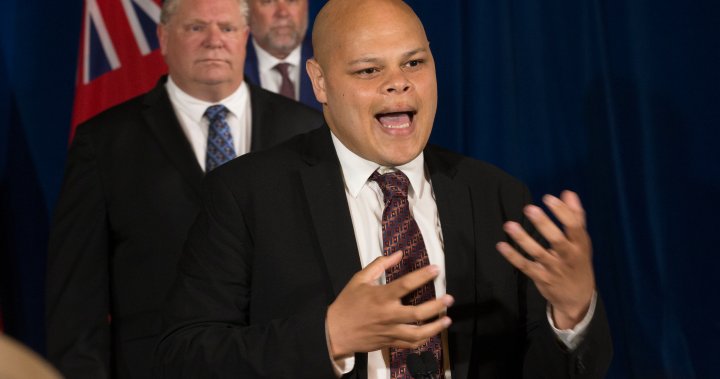Jamil Jivani, earlier this week, won the right to be the next member of Parliament for the Ontario riding of Durham, succeeding former Conservative leader Erin O’Toole.
In doing so he also became the first Black man to hold a seat in the 20-year-old history of the modern Conservative Party of Canada.
Jivani’s byelection win follows two sets of byelections in 2023, the first full year in which Pierre Poilievre was Conservative leader, and those byelections brought two South Asian men into the Conservative caucus: Shuvaloy Majumdar in Calgary—Heritage and Arpan Khanna in the Ontario riding of Oxford.
Jivani, Majumdar, and Khanna joined a caucus where one deputy leader, Melissa Lantsman, is a gay Jewish woman and the other, Tim Uppal, is a turbaned Sikh.
That group of young, diverse MPs will almost certainly form the core of a Poilievre cabinet should he ever get the opportunity to form one.
“Not every one of these names may be a household name yet,” said Jason Kenney, the former Alberta premier who spent years in federal politics and laid the foundations for the federal Conservative’s ethnic outreach program.
“Maybe some of them don’t have a big prior elected record, but there are truly talented and accomplished people stepping up. And I think any objective observer can start to see the outlines of a credible cabinet.“
Poilievre’s tenure as leader thus far has featured a renewed focus on connecting with Canada’s cultural communities and finding a way to diversify the gender and ethnic mix of his overwhelmingly white and male caucus.
Of the 117 Conservative MPs in the House of Commons before Monday’s byelection, 86 are white men.
The election of Jivani, Majumdar, and Khanna alone nearly doubled the number of visible minority MPs in that caucus. With Jivani’s arrival, that number now stands at eight.

Other parties, too, lag on some diversity benchmarks but none so far as the Conservatives.
“There is, I think, clear recognition by all parties, including the Conservatives, that they need to have candidates that represent or perceive to represent and serve the distribution of the voters in the particular ridings,” said Andrew Griffith a researcher and Canadian Global Affairs Institute fellow who has studied multiculturalism and candidate diversity.
The email you need for the day’s
top news stories from Canada and around the world.
Griffith analyzed the candidate makeup among all parties through the last three general elections and found the Conservatives increased the proportion of visible minority candidates from 14.2 per cent in 2015 to 16.6 per cent in 2019 and 17.2 per cent in 2021.
In 2021, looking at candidates from all parties, Griffith and his research partner Jerome Black found about 18.2 per cent were visible minorities. That number was set against an electorate in which about 20 per cent of all voters are visible minorities.
“All parties have increased the number of visible minority candidates, women candidates,” Griffith said. “That’s sort of a general trend.”
The Conservative ratio of visible minority candidates was lower in 2021 than the same ratio for the NDP and the Liberals but better than that for the Bloc Quebecois, the Greens, and the People’s Party of Canada.

Poilievre and his leadership team are clearly making an effort to continue to boost not only visible minority candidates but visible minority MPs, with some nominations in ridings that, as the polls stand now, look eminently winnable.
Parm Gill, a South Asian man, quit Doug Ford’s cabinet, and will run in the Ontario riding of Milton. Indigenous leader and former B.C. cabinet minister Ellis Ross has the Conservative nomination in the northwestern B.C. riding of Skeena-Bulkley Valley. And two women — former Toronto city councillor Karen Stintz and former National Post columnist Sabrina Maddeaux — have been tapped to run in two Greater Toronto Area ridings that the Conservatives believe will be pick-ups from the Liberals.
“It’s important for Canadians to know that they have a place in the Conservative Party. Pierre Poilievre has been saying that very openly to Canadians, that you have a place in our party, and we’re here to listen,” said Uppal, the MP for Edmonton Mill Woods.
Since its formation in 2004 and under its first leader, Stephen Harper, the Conservative Party has made a conscious effort to woo Canada’s cultural communities, an effort Kenney was closely identified with.
In their view, it was not only the right thing to do, it was also the clearest path to electoral success.
“If you want to be a governing party and form a winning coalition, it has to include people of all different backgrounds and parts of the country, and that includes new Canadians and second and third generation Canadians,” Kenney said in a recent interview.
“For a long time, the Conservative Party had forgotten to just show up with many new Canadian communities. We changed that in the Harper years.”
But by the time Harper was running his last election as leader in 2015, the party made some moves that alienated many first- and second-generation Canadians.
Harper campaigned on a plan to introduce a “Barbaric Cultural Practices” tip line and threatened to take away the Canadian citizenship of any dual-national convicted of treason or terrorism. Justin Trudeau in the 2015 election responded on the campaign trail with by repeating the line “A Canadian is a Canadian is a Canadian” – a signal that his party would protect the citizenship of dual nationality Canadians.
“It’s actually not that simple,” Griffith said, “but it was a very effective political point.”
The work Kenney et al had done had taken a hit. Bridges needed to be re-built.
Poilievre, for his part, has been spending many weekends since he became leader on the road across the country in temples, at cultural centres, and at ethnic festivals. His social media feeds are filled with pictures of the leader surrounded by smiling Asian, South Asian, Chinese, and Filipino faces.
“It’s a very, very positive thing to see because our party is a big blue tent,” said Khanna, who before he was elected, worked to connect those cultural communities with the party, “We always talk about that. And most people share the same values as us, same values of faith, family and freedom.”

And yet, unlike other parties, the Conservative Party of Canada has never had any target numbers or affirmative action program for women or visible minority candidates.
“The Conservatives instead believe in, frankly, equality of opportunity,” Kenney said. “Everybody gets a shot at a nomination, but they’ve got to win it on their own steam.”
The New Democrats, by contrast, have a party rule, endorsed by its members, that require that a member of what the NDP calls “an equity-seeking group” be named as the NDP candidate in any riding vacated by a sitting NDP MP. That rule will apply in the by-election to take place in the Winnipeg riding of Elmwood-Transcona where Daniel Blaikie — a white male — has announced his intention to resign.
The Liberals have no such mandatory requirements but the party does have a search committee aimed to boosting its gender and ethnic diversity and has committed to a target of having women make up 30 per cent of candidates in a general election. The current Liberal caucus of 156 MPs includes 57 women — about 37 per cent — and of those, 16 are members of visible minorities.
Kenney believes the Conservative method — no targets combined with grassroots outreach — works, albeit at a slower pace.
“I think it’s taken a while for a lot of the people with those diverse backgrounds to make their way through the system and actually win nominations because one thing that the Conservative Party does — unique from the Liberals — is we actually have competitive nominations,” Kenney said.
David Akin is the chief political correspondent for Global News.





